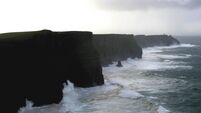Several butterfly species face extinction
The two are among the one-third of Irish butterfly species suffering declining populations and loss of natural habitat. Eleven of the 33 native species, including the Marsh Fritillary, are categorised as endangered, threatened or near-threatened, while the Pearl-Bordered Fritillary, Small Blue and Wall Brown are feared to be facing extinction.
They are not alone — five out of our 24 species of damselfly and dragonfly, 51 of our 150 molluscs, 65 of our 244 water beetles and 42 of our 102 bees, as well as three of our 26 mammals and various birds and plants, are all under threat.
Dublin Zoo, better known for its exotic species, is putting the spotlight on native wildlife this weekend in an effort to educate the public about their plight and boost conservation efforts.
Native Species Weekend, which runs today and tomorrow, will feature displays and talks by many of the country’s wildlife champions, including Bat Conservation Ireland, the Irish Wildlife Trust, the Environmental Protection Agency and Sustainable Energy Ireland.
The zoo’s Family Farm will host workshops for young visitors with environmental awareness officers on hand on how to make nest boxes and bird feeders and reveal other tips for making gardens more welcoming to native species, and visitors will also get to plant their on vegetables and herbs to take away.
Reminders of some of the animals that have been lost to the country will be on display, including rare fossils from a young Ichthyosaur, a dolphin-like creature which made its home in Irish seas in the Jurassic period, and skin from the brown bear, which lived here up to 7,700 years ago.
A recent extinction was the Mountain Ringlet butterfly which has not been seen here for 100 years but which was once plentiful on upland meadows. Habitats most at risk of losing butterflies include coastal heaths, dunes, bog and limestone regions.












